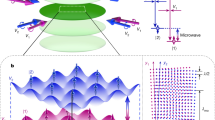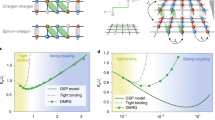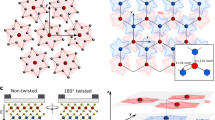Abstract
Fermionic atoms in optical lattices have served as a useful model system in which to study and emulate the physics of strongly correlated matter. Driven by the advances of high-resolution microscopy, the current research focus is on two-dimensional systems1,2,3, in which several quantum phases—such as antiferromagnetic Mott insulators for repulsive interactions4,5,6,7 and charge-density waves for attractive interactions8—have been observed. However, the lattice structure of real materials, such as bilayer graphene, is composed of coupled layers and is therefore not strictly two-dimensional, which must be taken into account in simulations. Here we realize a bilayer Fermi–Hubbard model using ultracold atoms in an optical lattice, and demonstrate that the interlayer coupling controls a crossover between a planar antiferromagnetically ordered Mott insulator and a band insulator of spin-singlets along the bonds between the layers. We probe the competition of the magnetic ordering by measuring spin–spin correlations both within and between the two-dimensional layers. Our work will enable the exploration of further properties of coupled-layer Hubbard models, such as theoretically predicted superconducting pairing mechanisms9,10.
This is a preview of subscription content, access via your institution
Access options
Access Nature and 54 other Nature Portfolio journals
Get Nature+, our best-value online-access subscription
$29.99 / 30 days
cancel any time
Subscribe to this journal
Receive 51 print issues and online access
$199.00 per year
only $3.90 per issue
Buy this article
- Purchase on Springer Link
- Instant access to full article PDF
Prices may be subject to local taxes which are calculated during checkout




Similar content being viewed by others
Data availability
The data presented in the figures are available at https://osf.io/u9wj6. More detailed data and information of this study are available from the corresponding author upon request.
Code availability
The DQMC theory simulations were performed using the QUEST Fortran 90/95 package, version 1.44, from https://code.google.com/archive/p/quest-qmc/.
References
Greif, D. et al. Site-resolved imaging of a fermionic Mott insulator. Science 351, 953–957 (2016).
Cheuk, L. W. et al. Observation of 2D fermionic Mott insulators of 40K with single-site resolution. Phys. Rev. Lett. 116, 235301 (2016).
Cocchi, E. et al. Equation of state of the two-dimensional Hubbard model. Phys. Rev. Lett. 116, 175301 (2016).
Cheuk, L. W. et al. Observation of spatial charge and spin correlations in the 2D Fermi–Hubbard model. Science 353, 1260–1264 (2016).
Parsons, M. F. et al. Site-resolved measurement of the spin-correlation function in the Fermi–Hubbard model. Science 353, 1253–1256 (2016).
Drewes, J. H. et al. Antiferromagnetic correlations in two-dimensional fermionic Mott-insulating and metallic phases. Phys. Rev. Lett. 118, 170401 (2017).
Mazurenko, A. et al. A cold-atom Fermi–Hubbard antiferromagnet. Nature 545, 462–466 (2017).
Mitra, D. et al. Quantum gas microscopy of an attractive Fermi–Hubbard system. Nat. Phys. 14, 173–177 (2018).
Scalettar, R. T., Cannon, J. W., Scalapino, D. J. & Sugar, R. L. Magnetic and pairing correlations in coupled Hubbard planes. Phys. Rev. B 50, 13419–13427 (1994).
Maier, T. A. & Scalapino, D. Pair structure and the pairing interaction in a bilayer Hubbard model for unconventional superconductivity. Phys. Rev. B 84, 180513 (2011).
Kancharla, S. S. & Okamoto, S. Band insulator to Mott insulator transition in a bilayer Hubbard model. Phys. Rev. B 75, 193103 (2007).
Golor, M., Reckling, T., Classen, L., Scherer, M. M. & Wessel, S. Ground-state phase diagram of the half-filled bilayer Hubbard model. Phys. Rev. B 90, 195131 (2014).
dos Santos, R. R. Magnetism and pairing in Hubbard bilayers. Phys. Rev. B 51, 15540–15546 (1995).
Rüger, R., Tocchio, L. F., Valentí, R. & Gros, C. The phase diagram of the square lattice bilayer Hubbard model: a variational Monte Carlo study. New J. Phys. 16, 033010 (2014).
Sandvik, A. & Scalapino, D. Order–disorder transition in a two-layer quantum antiferromagnet. Phys. Rev. Lett. 72, 2777–2780 (1994).
Hafermann, H., Katsnelson, M. & Lichtenstein, A. Metal–insulator transition by suppression of spin fluctuations. Europhys. Lett. 85, 37006 (2009).
Koepsell, J. et al. Robust bilayer charge-pumping for spin-and density-resolved quantum gas microscopy. Phys. Rev. Lett. 125, 010403 (2020).
Hartke, T., Oreg, B., Jia, N. & Zwierlein, M. Doublon–hole correlations and fluctuation thermometry in a Fermi–Hubbard gas. Phys. Rev. Lett. 125, 113601 (2020).
Wurz, N. et al. Coherent manipulation of spin correlations in the Hubbard model. Phys. Rev. A 97, 051602 (2018).
Scalettar, R. T. Magnetism and spin liquid behavior in a two layer Hubbard model. J. Low Temp. Phys. 99, 499–504 (1995).
Greif, D., Uehlinger, T., Jotzu, G., Tarruell, L. & Esslinger, T. Short-range quantum magnetism of ultracold fermions in an optical lattice. Science 340, 1307–1310 (2013).
Bouadim, K., Batrouni, G. G., Hébert, F. & Scalettar, R. Magnetic and transport properties of a coupled hubbard bilayer with electron and hole doping. Phys. Rev. B 77, 144527 (2008).
Varney, C. N. et al. Quantum Monte Carlo study of the two-dimensional fermion Hubbard model. Phys. Rev. B 80, 075116 (2009).
Acknowledgements
This work has been supported by BCGS, the Alexander-von-Humboldt Stiftung, DFG (SFB/TR 185 project B4), Cluster of Excellence Matter and Light for Quantum Computing (ML4Q) EXC 2004/1 - 390534769 and Stiftung der deutschen Wirtschaft.
Author information
Authors and Affiliations
Contributions
The idea for the experiment was conceived by M.G., N.W., C.F.C. and M.K. Data taking was performed by M.G., N.W. and C.F.C. with contributions by J.S. Data analysis was primarily performed by M.G. and N.W. Numerical simulations were performed by C.F.C. and N.W. The results were discussed and interpreted by all coauthors, and the manuscript was written by M.K. with contributions from all coauthors.
Corresponding author
Ethics declarations
Competing interests
The authors declare no competing interests.
Additional information
Peer review information Nature thanks the anonymous reviewer(s) for their contribution to the peer review of this work.
Publisher’s note Springer Nature remains neutral with regard to jurisdictional claims in published maps and institutional affiliations.
Rights and permissions
About this article
Cite this article
Gall, M., Wurz, N., Samland, J. et al. Competing magnetic orders in a bilayer Hubbard model with ultracold atoms. Nature 589, 40–43 (2021). https://doi.org/10.1038/s41586-020-03058-x
Received:
Accepted:
Published:
Issue Date:
DOI: https://doi.org/10.1038/s41586-020-03058-x
This article is cited by
-
Charge density wave surface reconstruction in a van der Waals layered material
Nature Communications (2023)
-
Atomic Bose–Einstein condensate in twisted-bilayer optical lattices
Nature (2023)
-
Superconductivity, superfluidity and quantum geometry in twisted multilayer systems
Nature Reviews Physics (2022)
-
Strong pairing in mixed-dimensional bilayer antiferromagnetic Mott insulators
Nature Physics (2022)
-
Quantum gases in optical boxes
Nature Physics (2021)
Comments
By submitting a comment you agree to abide by our Terms and Community Guidelines. If you find something abusive or that does not comply with our terms or guidelines please flag it as inappropriate.



